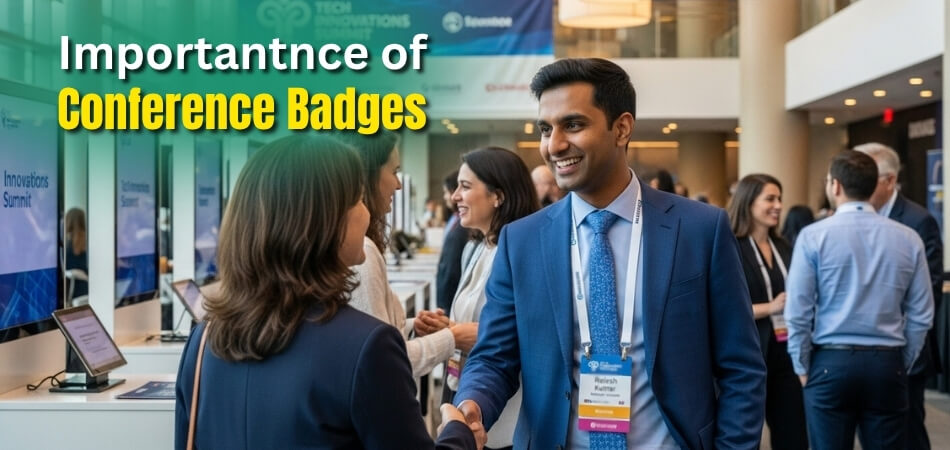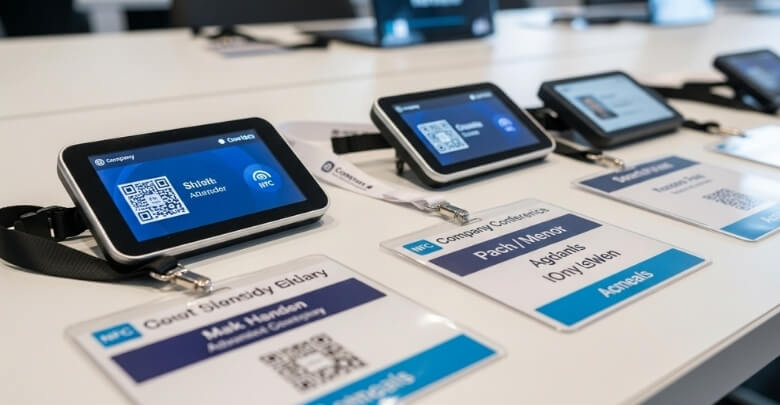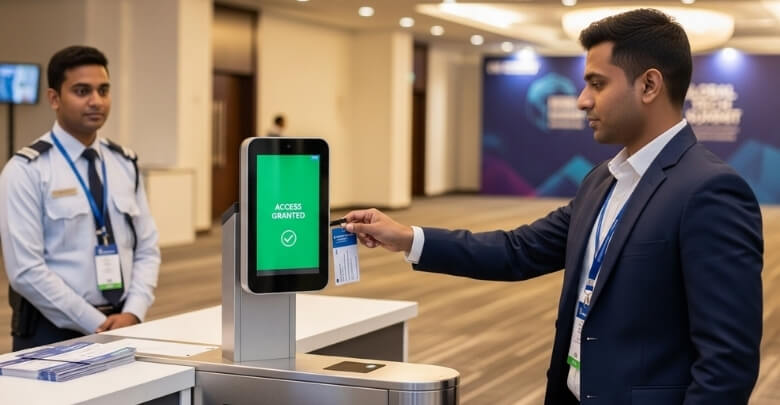Walking into a busy conference hall, one of the first things you’ll notice is that everyone is wearing a badge. It may look small, but it plays a big role in shaping first impressions and connecting people in a meaningful way. Every badge tells a story of identity and purpose.
So, why are conference badges important? They make introductions easier, help organizers maintain order, and allow participants to identify one another quickly. More than just name tags, they create a sense of belonging, professionalism, and trust among attendees throughout the event.
From building connections to enhancing brand visibility, badges do far more than most realize. Keep reading to discover how these small details can make a big difference in every conference experience.
Why Are Conference Badges Important?
Stepping into a conference, the first thing people notice is your badge. It’s more than a name tag; it’s your professional identity for the event. A conference badge introduces who you are, what you represent, and gives others an easy way to connect with you.

Beyond identification, badges encourage networking and professionalism. They make it simple for attendees to start conversations, remember faces, and approach the right people confidently.
Now, let’s see how conference badges add professionalism and structure to events, particularly for participants attending upcoming conferences in USA and other global destinations.
Simplify Identification and Communication
Conference badges help participants instantly identify one another. They display key details such as name, role, and organization, reducing awkward introductions. This quick visibility encourages smoother communication, especially in large gatherings where remembering names and titles would otherwise be challenging for both attendees and event organizers.
Build Credibility and Professional Trust
Badges establish a sense of professionalism and authority. When attendees see official credentials displayed clearly, it enhances mutual trust. They signal verified participation, making every interaction more authentic. Organizers also use badges to separate speakers, staff, or sponsors, maintaining structure and confidence across all sessions.
Encourage Meaningful Networking
A well-designed badge acts as a bridge between strangers. Seeing shared interests, industries, or roles makes it easier to start relevant conversations. Attendees feel more comfortable engaging when they can immediately recognize others’ professional backgrounds. In short, badges create opportunities for collaboration and long-term professional connections.
Support Event Management and Organization
From registration counters to access control, badges streamline the event process. They help staff verify entries, manage attendance, and categorize participants efficiently. In large conferences, color-coded or digital badges simplify coordination, ensuring every attendee finds the right session, meeting, or networking area without confusion.
Reflect the Event’s Professional Standard
A conference badge represents the event’s attention to detail. High-quality, well-branded badges signal that the organizers value professionalism and attendee experience. This small but significant element can influence how participants perceive the overall event, reflecting credibility, trust, and care in every interaction.
In short, conference badges are more than identifiers; they’re conversation starters, trust builders, and symbols of professionalism. They shape first impressions, foster meaningful engagement, and bring structure to every event. A simple badge often holds the power to transform how people connect and collaborate within a conference.
How Design and Visibility Impact Attendee Experience?
Design plays a huge role in how attendees interact and feel during a conference. A thoughtfully designed badge not only helps people recognize one another easily but also leaves a lasting impression about the event’s professionalism. Let’s explore how thoughtful design elements directly influence the attendee experience and make conference badges truly effective.
Improve Readability Through Smart Design Choices
Readable badges make a strong first impression. Using the right font size, clear typography, and proper color contrast ensures names and details are visible from a comfortable distance. A well-placed badge, ideally at chest level, allows attendees to identify one another effortlessly, creating instant comfort and boosting communication confidence.
Build Confidence and Engagement Among Attendees
When attendees can easily read and recognize others’ names, they feel more at ease starting conversations. Clear visibility minimizes awkwardness and promotes active networking. It also enhances engagement during sessions, as participants can address speakers or peers by name, strengthening professional bonds and building community.
Maintain Branding Consistency Across the Event
A badge’s design should mirror the overall theme of the conference. Matching colors, fonts, and logos builds a unified brand identity that reinforces the event’s message. This consistency helps attendees associate professionalism with the organization, leaving a positive impression long after the event concludes.
Create a Sense of Belonging Through Design Aesthetics
Well-designed badges make participants feel valued and part of something significant. When attendees receive a visually appealing badge, it enhances their sense of inclusion and pride in being there. Unique design touches, like embossed logos or quality lanyards, show care and attention to detail.
Turn Badges Into Memorable Keepsakes
Creative design elements can transform badges into cherished souvenirs. From custom shapes to collectible event editions, a thoughtful design encourages attendees to keep their badges as reminders of valuable experiences. These small details help your event stay remembered and talked about long after it ends.
Good design is more than aesthetics—it shapes perception, comfort, and engagement. When badges are visually appealing, easy to read, and brand-aligned, they enhance the overall attendee experience. A well-crafted badge doesn’t just display identity; it reflects the event’s spirit and the professionalism behind it.
The Shift Toward Digital and Smart Conference Badges
Technology has transformed nearly every aspect of events, and badges are no exception. What once served as simple paper identifiers has now evolved into digital tools that make conferences more efficient and interactive. Let’s explore how smart badges are redefining convenience, networking, and event management through innovation and connectivity.
From Paper Tags to Smart Digital Badges
Traditional paper badges are giving way to smart versions that use QR codes, NFC chips, or mobile integrations. Today, event organizers use different types of conference badges to meet various attendee needs, combining traditional and digital features for better flexibility. These features allow attendees to check in effortlessly and share contact details in seconds. They eliminate manual processes, reduce errors, and improve the overall flow of registration and verification.
Connecting Attendees Through Digital Profiles
Smart badges can link directly to an attendee’s digital profile or company information. When scanned, they reveal key details such as social links, bios, and schedules. This helps professionals connect instantly without exchanging printed cards, promoting a more seamless and eco-friendly networking experience.
Simplifying Registration and Networking
Digital badges make registration faster and smoother by allowing pre-event verification. Attendees can scan in at entrances or sessions without waiting in line. Contactless networking options, like tapping badges to exchange digital business cards, make introductions effortless and time-saving for participants.
Delivering Real-Time Data for Organizers
Smart badges provide valuable insights for event organizers. They track attendance, monitor session popularity, and collect engagement data in real time. This information helps organizers improve event planning, manage capacity, and design better experiences based on attendee behavior and preferences.
Global Events Adopting Smart Badge Systems
Many major conferences around the world now rely on mobile or smart badge systems. Events like CES and Web Summit use technology-based identification to manage large crowds, track engagement, and personalize attendee interactions. These examples highlight how innovation is reshaping event efficiency globally.
The rise of digital and smart badges is redefining how conferences operate, blending convenience with intelligence. As technology continues to evolve, the balance between innovation and data security will become even more crucial. Smart badges mark the future of event engagement, where every connection is just a scan away.
Security and Access Control Benefits of Conference Badges
Security plays a major role in the success of any professional event. Conference badges act as more than identification; they serve as built-in tools for managing access and ensuring smooth organization. Let’s look at how modern badge systems enhance security, simplify access control, and make event management more reliable and transparent.
Badges as Secure Access Tools
Conference badges define who can enter specific areas within the venue. From restricted zones and VIP lounges to speaker halls and backstage sections, badges help maintain clear boundaries. Organizers can easily identify authorized attendees while ensuring that only permitted individuals enter sensitive or exclusive spaces.
Barcode and RFID Scanning for Tracking Attendance
Advanced badges often come equipped with barcodes or RFID chips that record entry and exit data. Scanning these badges at different checkpoints helps organizers track attendance accurately. This not only enhances safety but also allows for better crowd control and resource allocation during busy sessions.
Preventing Unauthorized Entry Through Color Coding
Color-coded badges or digital access levels make it simple to differentiate between attendees, exhibitors, media, and staff. This visual clarity minimizes confusion and prevents unauthorized access. The use of digital permissions within smart badges further tightens security without slowing down movement between event zones.
Improving Event Logistics Through Security Data
Data collected from badge scans provides organizers with valuable insights. They can identify high-traffic areas, adjust staffing needs, and optimize crowd flow based on real-time analytics. This level of organization not only improves efficiency but also creates a safer, more enjoyable environment for all participants.
Conference badges bring together safety, order, and efficiency under one system. By combining access control with data insights, organizers can run smoother events while protecting attendees. The streamlined processes and reduced paper usage also connect security innovation to sustainability, setting the stage for more eco-friendly event solutions ahead.
Why Sustainability Matters in Modern Badge Printing?
Sustainability has become a central focus in today’s event industry. Organizers are moving beyond convenience to consider the environmental impact of every element, including conference badges. Let’s explore how sustainable badge printing practices are changing the way conferences operate and how they create a positive impression among attendees.
Using Eco-friendly and Recyclable Materials
Modern conference badges are now often made from recycled paper, biodegradable plastics, or reusable materials. Many organizers also choose durable conference badge materials for longer use. These sustainable alternatives significantly reduce waste compared to traditional laminated badges. Even lanyards are being crafted from organic cotton or recycled fibers, promoting a more environmentally conscious event setup.
Reducing Waste with Digital Alternatives
Digital badges are becoming an increasingly popular choice for eco-focused events. By replacing printed badges with mobile or QR-based options, organizers eliminate paper waste altogether. These digital solutions simplify check-ins, reduce printing costs, and contribute to a cleaner, paper-free conference experience.
Enhancing Event Reputation Through Green Practices
Sustainable badge printing not only benefits the environment but also strengthens an event’s public image. Attendees often view eco-friendly practices as signs of professionalism and integrity. When an organization prioritizes sustainability, it communicates awareness and care, which helps build trust and positive brand perception.
Creating a Positive Attendee Experience
Participants appreciate when events demonstrate environmental responsibility. Small details, like recyclable badges or returnable holders, show that organizers value sustainability as much as convenience. This fosters goodwill and makes attendees feel they are part of a community that supports meaningful global change.
Sustainability in badge printing goes far beyond reducing waste; it builds credibility and fosters respect for both the event and its organizers. Eco-friendly choices reflect thoughtful leadership and align with attendee expectations. As events grow greener, they open doors for greater brand visibility and meaningful sponsor engagement ahead.
How Sponsors Gain Visibility Through Branded Badges?
Sponsorship visibility is an essential part of any conference’s success. Badges offer a unique and constant form of brand exposure, as attendees wear them throughout the event. For sponsors, this means gaining recognition in a professional setting while adding value to the overall event experience for participants. Let’s look at how branded badges help sponsors strengthen visibility.
Creating Brand Awareness Through Logo Placement
When sponsors’ logos are featured on badges, they gain continuous visibility across sessions, photos, and networking areas. Every glance at the badge serves as a subtle brand reminder. This constant exposure helps sponsors reach diverse audiences organically while reinforcing their connection to the event’s professionalism.
Delivering Dual Benefits for Events and Sponsors
Branded badges not only highlight sponsors but also elevate the event’s image. Featuring well-known brands adds a layer of trust and legitimacy, signaling a high-value experience for attendees. Sponsors benefit from exposure, while organizers enjoy enhanced credibility — a mutually beneficial relationship that supports both marketing and event goals.
Expanding Brand Reach Through Co-branded Elements
Lanyards, badge holders, or QR codes co-branded with sponsor logos create additional touchpoints for visibility. These design elements blend function with promotion, ensuring sponsors are remembered. Scannable codes can even lead attendees to sponsor websites or special offers, making every interaction a chance for engagement.
Encouraging Interaction and Engagement Opportunities
Sponsor-branded badges can include unique features like discount codes, prize entries, or interactive event challenges. These creative ideas transform badges from simple identifiers into engagement tools. Attendees are more likely to participate in sponsor activities, resulting in better lead generation and brand recall after the event.
Branded conference badges go beyond promotion; they unite identity, networking, innovation, security, sustainability, and sponsorship under one design. For organizers, they enhance professionalism; for sponsors, they unlock continuous brand exposure and engagement. Ultimately, well-designed badges create a balanced ecosystem where visibility meets value for everyone involved.
Frequently Asked Questions
Conference badges might seem simple, but there’s much more behind their purpose and design. After exploring how they impact networking, branding, and sustainability, here are some common questions attendees and organizers often ask about them.
What Information Should Be Printed on a Conference Badge?
A conference badge should include the attendee’s name, job title, organization, and role type. Adding a logo or event name helps maintain branding consistency. Optional elements like QR codes can make check-ins and networking faster.
How Early Should Badges Be Prepared Before an Event?
It’s best to finalize and print badges at least a week before the event. This allows time for verification, corrections, and layout adjustments. Preparing early helps organizers avoid last-minute stress and printing delays.
Can Attendees Customize Their Conference Badges?
Some events allow minor customization, such as adding pronouns, flags, or interests. These details make badges more personal and inclusive. However, customization should still follow the overall design and visibility guidelines of the event.
Do Badge Colors Really Affect Event Organization?
Yes, color-coding badges help staff and attendees identify different groups easily. For example, red might be for speakers, blue for participants, and green for media. This system simplifies communication and keeps event management organized.
Are Reusable Badges a Practical Option for Organizers?
Reusable badges made from metal or sturdy plastic are gaining popularity. They reduce printing costs for recurring events and promote eco-friendly practices. Organizers can simply replace paper inserts while keeping the badge frames intact.
How Do Badges Support Contactless Event Experiences?
Modern badges with QR or NFC technology let attendees scan to exchange contact details or enter sessions. This creates a safer, touch-free experience. It also speeds up networking and data collection for both sides.
What Happens to Unused or Leftover Badges After Events?
Many organizers recycle leftover badges or donate materials for reuse. Some even repurpose them for training events or local workshops. This approach reduces waste and supports the growing focus on sustainable event practices.
Concluding Words
Badges may seem like minor details, but they carry great importance in creating a successful conference experience. They connect people, strengthen organizations, and add professionalism to every interaction, making attendees feel valued and recognized.
Understanding why are conference badges important helps organizers and participants realize how these simple tools influence communication and engagement. They help identify individuals, control access, and maintain smooth event management without confusion or delay.
Eventually, badges are more than identifiers; they represent trust, connection, and purpose. Whether digital, sustainable, or sponsor-branded, their role in shaping modern conferences remains unmatched. Paying attention to these small details can truly elevate how people experience and remember an event.








